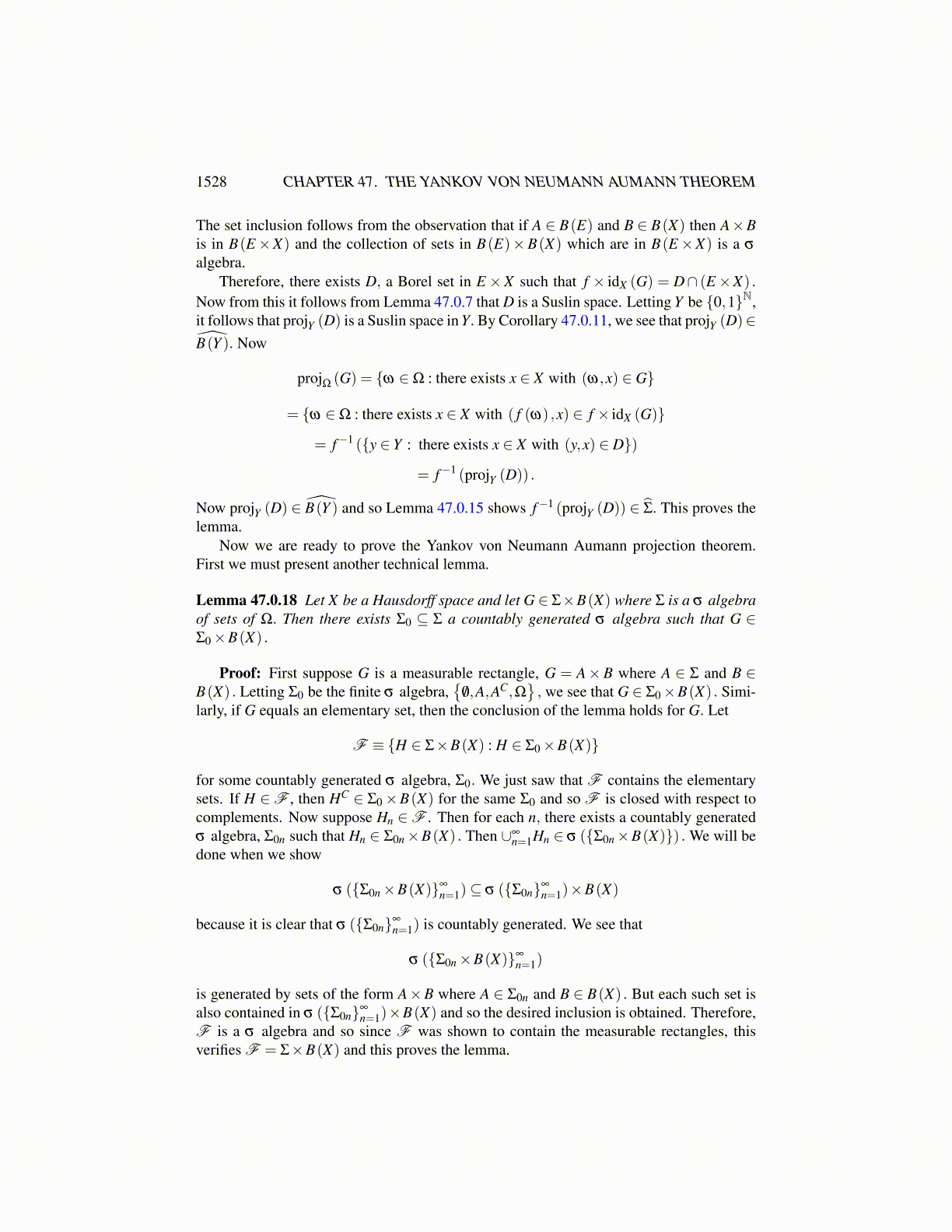
1528 CHAPTER 47. THE YANKOV VON NEUMANN AUMANN THEOREM
The interesting thing about separable measure spaces is that they are isomorphic to avery simple sort of measure space in which topology plays a significant role.
Lemma 47.0.14 Let (Ω,Σ) be separable. Then there exists E ∈ {0,1}N such that (Ω,Σ)and (E,B(E)) are isomorphic.
Proof: First we show {An} separates the points. Here σ ({An}) = Σ. We already knowΣ separates the points but now we show the smaller set does so also. If this is not so, thereexists ω,ω1 ∈Ω such that for all n, XAn (ω) = XAn (ω1) . Then let
F ≡ {F ∈ Σ : XF (ω) = XF (ω1)}
Thus An ∈F for all n. It is also clear that F is a σ algebra and so F = Σ contradicting theassumption that Σ separates points. Now we define a function from Ω to {0,1}N as follows.
f (ω)≡ {XAn (ω)}∞
n=1
We also let E ≡ f (Ω) . Since the {An} separate the points, we see that f is one to one. Asubbasis for the topology of {0,1}N consists of sets of the form ∏
∞i=1 Hi where Hi = {0,1}
for all i except one, when i = j and H j equals either {0} or {1} . Therefore,
f−1 (subbasic open set) ∈ Σ
because if H j is the exceptional set then this equals A j if H j = {1} and ACj if H j = {0} . In-
tersections of these subbasic sets with E gives a countable subbasis for E and so the inverseimage of all sets in a countable subbasis for E are in Σ, showing that f−1 (open set) ∈ Σ.Now we consider f (An) .
f (An)≡ {{λ k}∞
k=1 : λ n = 1}∩E,
an open set in E. Hence f (An) ∈ B(E) . Now letting
F ≡ {G⊆Ω : f (G) ∈ B(E)} ,
we see that F is a σ algebra which contains {An}∞
n=1 and so F ⊇ σ ({An}) ≡ Σ. Thusf (F) ∈ B(E) for all A ∈ Σ. This proves the lemma.
Lemma 47.0.15 Let φ : (Ω1,Σ1)→ (Ω2,Σ2) where φ−1 (U) ∈ Σ1 for all U ∈ Σ2. Then if
F ∈ Σ̂2, it follows φ−1 (F) ∈ Σ̂1.
Proof: Let µ be a finite measure on Σ1 and define a measure φ (µ) on Σ2 by the rule
φ (µ)(F)≡ µ(φ−1 (F)
).
Now let A ∈ Σ2φ(µ). Then by Lemma 47.0.12, A = A1∪N1 where there exists N ∈ Σ2 withφ (µ)(N) = 0 and A1 ∈ Σ2. Therefore, from the definition of φ (µ) , we have µ
(φ−1 (N)
)=
0 and therefore, φ−1 (A) = φ
−1 (A1)∪φ−1 (N1) where
φ−1 (N1)⊆ φ
−1 (N) ∈ Σ1